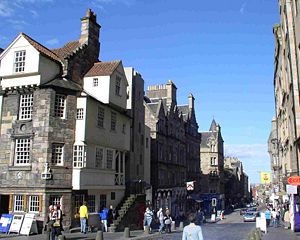John Knox House
John Knox House on the Royal Mile in the Old Town of Edinburgh in Scotland, is a town house, built before 1490. The house displays exhibits about John Knox, a Protestant leader born between 1505 and 1515, who died at Edinburgh on 24 November, 1572.
John Knox is a controversial figure in Scotland's history, who was appointed minister of the Church of St. Giles' when the Reformed Protestant religion was ratified by law in Scotland in 1560. His History of the Reformation made him a leading figure in the Scottish reformation. He was outspoken in his attacks on the Catholic clergy of Scotland, accusing them of being "gluttons, wantons and licentious revelers." The distaste was mutual; according to the Catholic Encyclopedia [1], "permeated with the spirit of the Old Testament and with the gloomy austerity of the ancient prophets, [Knox] displays neither in his voluminous writings nor in the record of his public acts the slightest recognition of the teachings of the Gospel, or of the gentle, mild, and forgiving character of the Christian dispensation."
Unknown until past forty, [Knox] had then before him five-and-thirty years of splendid and influential life, passed through uncommon hardships to an uncommon degree of power, lived in his own country as a sort of king, and did what he would with the sound of his voice out of the pulpit. And besides all this, such a following of faithful women! One would take the first forty years gladly, if one could be sure of the last thirty. Most of us, even if, by reason of great strength and the dignity of gray hairs, we retain some degree of public respect in the latter days of our existence, will find a falling away of friends, and a solitude making itself round about us day by day, until we are left alone with the hired sick-nurse. For the attraction of a man's character is apt to be outlived, like the attraction of his body; and the power to love grows feeble in its turn, as well as the power to inspire love in others. It is only with a few rare natures that friendship is added to friendship, love to love, and the man keeps growing richer in affection - richer, I mean, as a bank may be said to grow richer, both giving and receiving more - after his head is white and his back weary, and he prepares to go down into the dust of death.</blockquote [2]
References
- ↑ D.O. Hunter-Blair. John Knox. The Catholic Encyclopedia, Volume VIII. Published 1910. New York: Robert Appleton Company. Nihil Obstat, October 1, 1910.
- ↑ ‘John Knox and his Relations to Women’ by Robert Louis Stevenson
